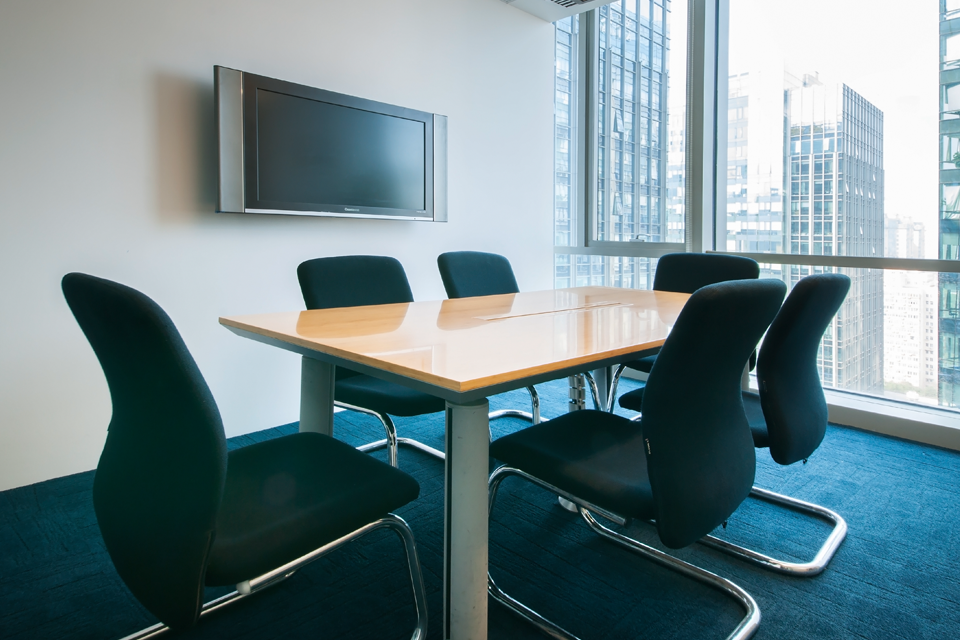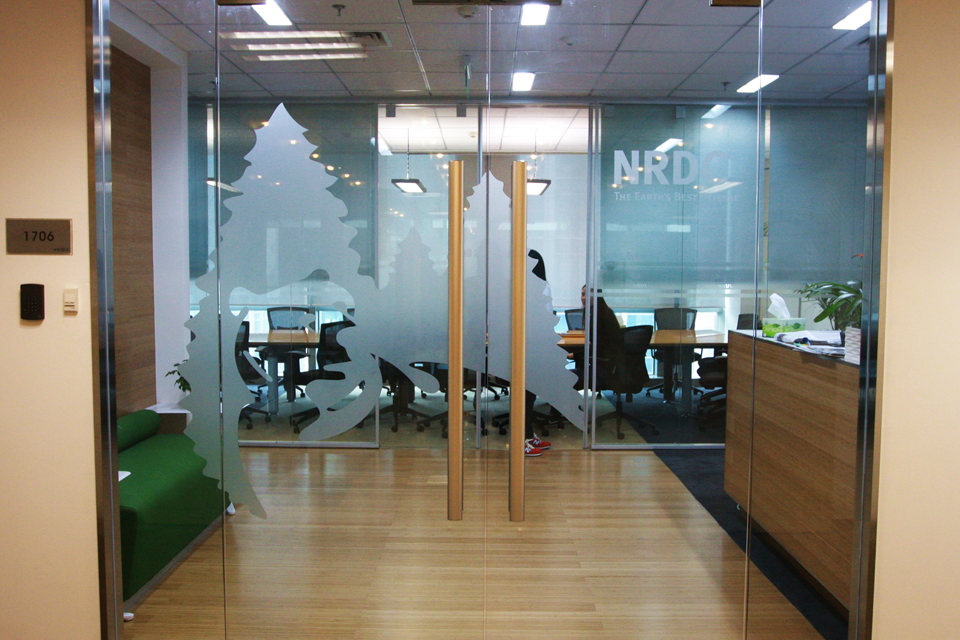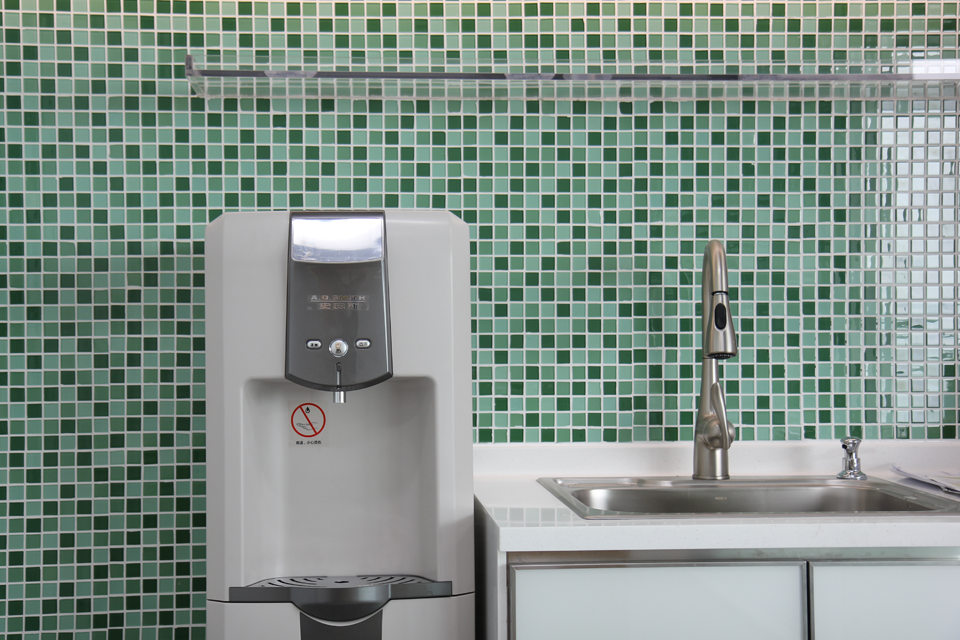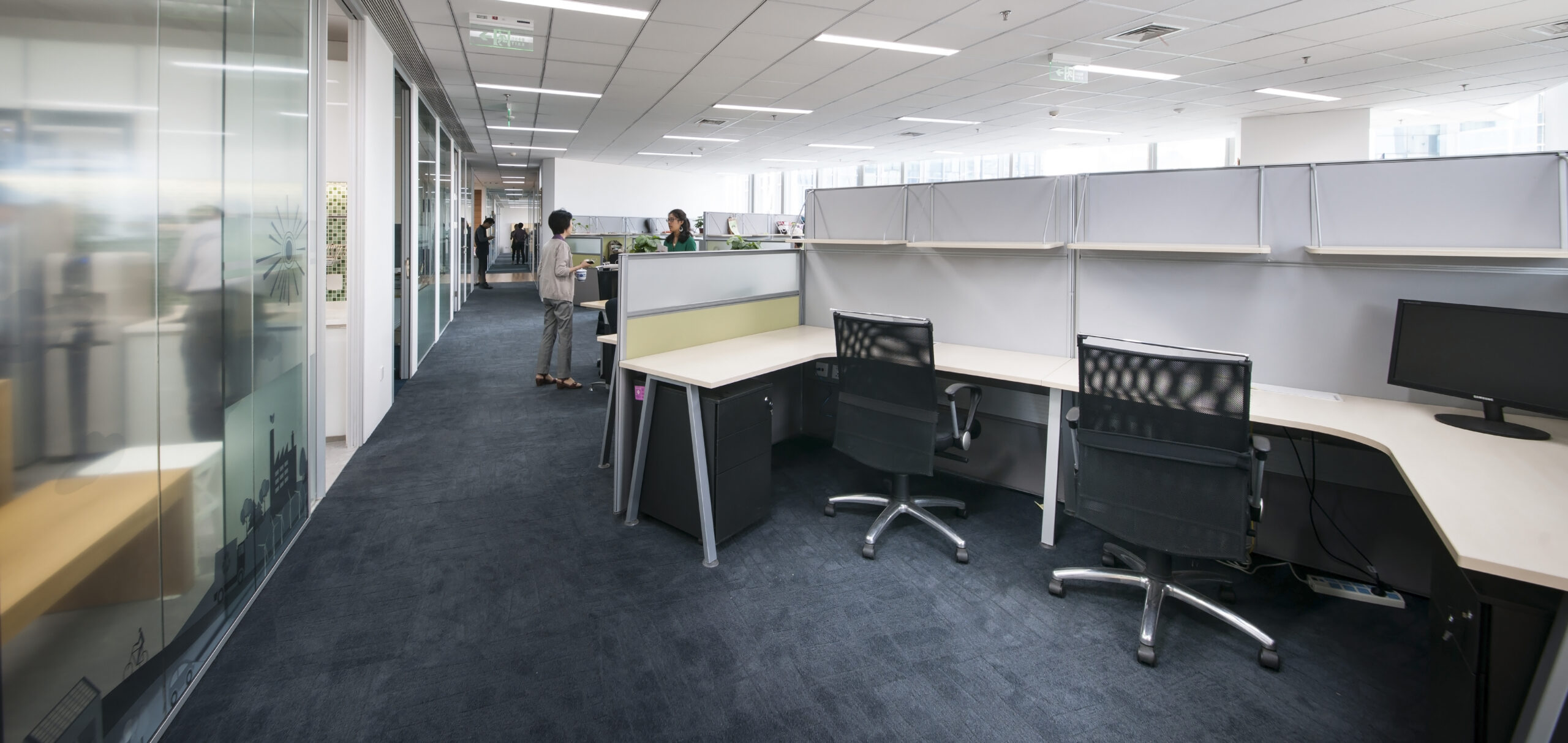The Natural Resources Defense Council’s (NRDC) China program office is located in the CBD area of Beijing. Due to the nature of short leases in Beijing, NRDC worked with the design-build contractor, MMoser, to re-use almost all of the furniture NRDC already owns and some of the other fixtures such as lights and sensors. The space has floor to ceiling windows on the north and east exposures and with a narrow floor plate it provides ample light and on a clear day, spectacular views. The program includes a mixture of interior offices, open workstation areas, several meeting spaces and a pantry.
NRDC has acheived Petal Certification for renovation and designed according to the requirements of the Site, Materials and Beauty petals. Additional sustainability measures include high energy efficiency with dimmable lighting, daylight and motion sensors, no supplemental cooling for the IT room, and a kill switch to stop electricity flow when its not needed. Low-flow fixtures were installed in the pantry. Indoor air quality was addressed by making every effort to reduce the introduction of toxics and pollutants into the space.
VITAL STATS
| Certification Status | Certified Petal on March 26th, 2015 |
| Location | Beijing, China |
| Living Transect | L6 – Urban Core |
| Typology | Renovation |
| Occupant Type | Commercial Office, Non-Profit |
PROJECT TEAM
| Architectural | MMoser Associates, Beijing |
| Interior Design | MMoser Associates, Beijing |
| Plumbing | MMoser Associates, Beijing |
| Mechanical | MMoser Associates, Beijing |
| Electrical | MMoser Associates, Beijing |
| Lighting Design | MMoser Associates, Beijing |
| Specialty Consultant(s) | Closed Loop Advisors, Owner’s Representative, New York, www.closedloopadvisors.com GIGA, Materials Consultant, www.gigabase.org |
| Contractor | MMoser Associates, http://www.mmoser.com/ |
PLACE PETAL

SITE INFO
PRIOR SITE CONDITION
Existing building/Previously developed – The NRDC selected the Taikang Financial Center as the location for their new Beijing office. The space is located just on the edge of the Central Business District and is a 38 story tower. While the building wasn’t completed until 2008, it stands in a previously developed site and was chosen for its access to public transportation and amenities. The Taikang Financial Tower has direct access to Hujialou Station of Subway lines 10 and 6, allowing employees to take advantage of public transportation to get to and from work. It’s also surrounded by a number of other office buildings, hotels and shopping malls, and is only a quick ride from the subway to the airport.
HABITAT EXCHANGE
Exception I03-E1 01/2013, Conservation and Parks Organizations. NRDC’s advocacy and funding were instrumental in the conservation of 340,000 acres within the Laguna San Ignacio Wetland Site, 75,000 acres of which is part of a larger World Heritage Site.
ADDITIONAL COMMENTS/LESSONS
In creating the first LBC project certified in China, the team not only had to overcome the difficulties inherent in the Challenge, but also faced new challenges with building in China. Primarily, the project team had to work quickly because construction in China moves at a rapid pace. This required quick decision-making. A design-build firm handled the design and construction. This is a common strategy for in China to ensure the design is executed to the high design standards, but not standard practice for the owner’s US-based projects. The team faced the issue of very short leases – also common in China – making it important to install fixtures that could be easily removed at the end of the lease. With poor air quality in China naturally ventilation was a concern and it became even more important to ensure a healthy environment in the office space.
MATERIALS PETAL

From the beginning, NRDC considered every team member crucial to the success of the Materials Petal imperatives. Therefore we chose our project team accordingly. The design build firm, MMoser, was chosen because they were recommended as knowing both sustainability and office projects. To assist with materials selection, NRDC engaged GIGABASE (GIGA), a Shanghai based materials expert, as the materials consultant. The expectation of pursuing the Materials Petal was set early on and every team member was made aware of the effort.
Due to the short nature of leases in Beijing, NRDC decided from the beginning to try to re-use as much as possible from the old office in the new one. MMoser and GIGA first evaluated what was salvageable. NRDC was able to leave most of the permanent finishes in their old space for the next tenant’s use, but did bring all of the furniture, lighting fixtures, dimmers, electronics and appliances to the new space. To limit the materials vetting, the design team also chose to use a simplified design approach. During design, MMoser and GIGA worked closely to review materials that would need to be newly specified. MMoser would propose a material and if it was not LBC compliant, GIGA would propose alternate options or suggestions for ways to find other compliant choices.
Cultural preference and aesthetics did come into play and often created a challenge for the designers. For example, bamboo was a must because of its cultural significance to China and the work that NRDC does to protect the natural environment. However, bamboo finishes typically contain added formaldehyde – a Red List ingredient – as a binder. The team reached out to multiple bamboo flooring manufacturers to find a product that did not contain formaldehyde and was ultimately able to identify a compliant product.
Finally, deconstructability was considered. Flooring is not tacked too strongly, furniture is not fixed, and the glass doors and windows are modular so they are removable at the end of the lease.
10. RED LIST IMPERATIVE
NOTABLE RED LIST SUBSTITUTIONS
- TANGDUN WALLBOARD
A new member of Declare, used instead of traditional gypsum board, which typically has added formaldehyde. - FORBO LINOLEUM
Utilized in lieu of PVC based resilient flooring and is another new member of Declare - VOXFLOOR
Selected as the carpet tile vendor due to its local manufacturing plant, its use of bio-based face fiber and PVC-free backing.
The project avoided PVC and toxic flame-retardants by specifying roller shades from Verosol who use a FR Polyester that is inherently flame retardant. A real find was the LSZH cable from Commscope, who not only has innovative low smoke technology built into their data cabling product line, but go even further with a casing that is PVC free; a very rare find in the electronic and telecommunications division in China. Glues and sealants that were used throughout were selected because they are Red List free. We were particularly pleased with the assistance from Laticrete for their transparency in product ingredients. It should be noted that before this project began, there were no Declare labels in China. At the end of this project we had registered 10 different products in the Declare program. Not all 10 products were given a place on this project, but the vendors and manufacturers of those products were prompted to submit their information to the Declare program nonetheless. They were inspired by the potential that this first Petal registered project augured and are now leading the way in China by example.
PRODUCT CHALLENGES
- BAMBOO
Bamboo was a real hurdle for the design team. What would seem to be an abundant and harmless material for China, is too often heavily impregnated with toxic binders and questionable chemicals. - LAMINATE & ENGINEERED FLOORING
Like nearly all laminate and engineered flooring, urea formaldehyde (UF) and phenol formaldehyde (PF) is simply par for the course in the manufacturing process. Lay on top of this the significant amount of tricky marketing techniques vendors use to avoid listing their ingredients and it makes for a very difficult task for teams to reveal if there are indeed non-compliant ingredients in the material or not. With much effort, the team was able to find a manufacturer who is using innovative bio-based binders and could also divulge its sourcing locations that were compliant with our zoning parameters.
11. EMBODIED CARBON FOOTPRINT IMPERATIVE
EMBODIED CARBON FOOTPRINT 200 (tCo2e)
PROJECT North Songshan Wind Power Project
LOCATION North Songshan District, China
PROVIDER The CarbonNeutral Company
WEBSITE www.carbonneutral.com
12. RESPONSIBLE INDUSTRY IMPERATIVE
REGIONAL PRODUCTS SPECIFIED
Clestra Hausserman and Voxfloor Carpets were two vendors that we were able to enter the Declare program largely due to their local manufacturing and local sourcing capabilities. Both manufacturers are ahead of the rest of the China market in that they have invested in top of the line manufacturing plants on the mainland. That reduces costs for raw materials sourcing and helps to more effectively monitor the quality of their products intended for the China market. This was a rare find again for the team since most vendors are still importing many of their raw ingredients and only utilizing China for its low-cost manufacturing costs, cheap energy and lower-wage labor force.
MANUFACTURERS WHO MADE ‘PROPRIETARY CLAIMS’ ABOUT PRODUCT CONTENTS
None were very notable. The one exception is Futeng Glass, who listed 73% proprietary claims.
WOOD SOURCES
Certified by Forest Stewardship Council (FSC), Salvaged , Harvested onsite
MANUFACTURERS OF FSC CERTIFIED WOOD PRODUCTS
FSC certification chain of custody is difficult to track in China so as a rule it was avoided. The one exception to that rule was the bamboo that was used in the reception area flooring and desk. It is not only Red List-free but FSC certified. The product is Plyboo Soybond Bamboo Flooring by the Smith & Fong Company and it falls under the following CSI division: 09 60 00 Flooring.
ADDITIONAL COMMENTS
The design-build process in China moves very quickly so there often wasn’t much time to vet materials without holding up the design process. In fact we did delay the project by two weeks in order to find compliant bamboo. The team took some educated guesses on materials that were likely compliant but not 100% vetted before ordering them. It also caused MMoser to re-sequence some of their processes in order to allow vetting time. However, the team was confident that they met requirements prior to installing them.
BEAUTY PETAL

19. BEAUTY & SPIRIT IMPERATIVE
The new office for the Natural Resources Defense Council (NRDC) in Beijing was designed, engineered and constructed by M Moser Associates to meet NRDC’s environmental and sustainability goals and also to express the beauty and spirit embodied by NRDC’s China program and mission. NRDC, as an organization, focuses on six priorities– curbing global warming, reviving the world’s oceans, defending endangered wildlife, protecting our health by preventing pollution, ensuring safe and sufficient water, and fostering sustainable communities. Specifically in China, the world’s most populous country undergoing rapid economic growth, NRDC provides the legal, regulatory and technical tools and know-how to develop more sustainably. NRDC helps to safeguard the quality of China’s air, water, soil and natural resources, protect the health of its citizens, and shift to cleaner energy sources and development models that will ensure the current and future well-being of its citizens and the planet.
The new Beijing office reflects this spirit by incorporating an aesthetically beautiful atmosphere that fosters productivity along with a cohesive and cooperative culture. With the help of GIGABASE, who consulted on materials, M Moser Associates designed the office and chose materials with this in mind. A mostly open floor plan with some interior offices was implemented to serve the functional needs of staff and allow for everyone to have access to daylight and exterior views. This configuration makes the space more equitable and democratic in nature and encourages collaboration between employees.
Further embodying the culture and spirit of NRDC, a number of the organization’s goals were addressed practically in the office design. The new office blends this practicality with aspects intended solely for human delight. In order to reduce the global warming impact of construction, unless the team couldn’t find Red List-free items, all materials and resources were locally sourced – including the staff that worked on the project – to reduce shipping and travel distances. These materials were then re-imagined to match the spirit of the new office and bring in a new aesthetic.
For example, bamboo, which has cultural significance in China and adds a natural feel to the office, was used for flooring in reception and to cover the reception desk. It was difficult to find local bamboo manufacturers that do not use added formaldehyde, a Red List item, as a binder. However, because the plant is considered to be so important by the staff for the cultural feel of the office, the team searched until they found a product called Plyboo, a bamboo flooring using soy as a binder rather than formaldehyde. Along with three other products, after finding Red List-free Plyboo, the project team assisted manufacturers in getting their products Declare labels to be listed in the Declare database. In the spirit of NRDC, this helps spread awareness of Red List-free products for use in other construction projects.
Another highlight is the design of the manifestation on the pantry glass partition. After a process of selection among different manifestations of bamboo, showing the nature of one of the sustainable resources used in other areas of the project, the final theme for this area was of an idyllic modern city, which uses sustainable energy and protects the environment. This advocates for the mission of the NRDC. A very simplistic design also highlights the green mosaic inside the pantry.
As this project was a relocation of the existing office of NRDC Beijing, one of the earliest premises to develop the layout was to reuse as much furniture as possible, as well as lighting, motion sensors and AV equipment. In order to achieve this, an exhaustive study of the furniture was done in order to incorporate and integrate it in the new design of the office.
The narrow floor plate of the new office was a consideration in the real estate selection process because it makes a greater amount of natural light accessible throughout the office. It also reduces the need for artificial lighting, which means potential energy savings as well as a more natural feel for the office. An advanced dimming system enhances occupants’ ability to appreciate natural lighting and energy savings.
In planning the spatial design of the office, the architect used the previous office as a design guideline, maintaining the number of enclosed offices and meeting rooms. The workstations were settled in an open plan along the curtain wall, bringing in natural light. The enclosed offices were placed on the core side, giving them more privacy, though they have glass partitions that allow employees to enjoy the natural light in the office. The linear circulation of the office optimizes the use of the space and improves the communication providing a functional and collaborative space. In the center of the layout are the reception desk and meeting space, which are the hearth of the office and are used very often for office meetings. The conference room, designed with the long side along the window, allows employees to enjoy the bright days in Beijing and also permits reception to take advantage of natural light. All this contribution of natural light helps the employees to be healthier, happier and calmer. A small detail in the layout is the south east corner, originally designed as a mother’s room, this open space allows the employees to have calls or have a break enjoying the privileged views of the east side of ChaoYang district, less crowded than the GouMao side.
The integrated project team allowed for a heightened level of coordination and integrated design. One of the singularities of this project was the integration of the sustainability experts into the core team, rather than supporting the team. They were involved in all the stages of the project from the early design stage – participating very actively in the materials sourcing and selection – until the project hand over and submissions for sustainability accreditations. During the process, designers, project managers, construction manager and sustainability specialist worked together to source materials and develop new construction techniques to be compliant with the LBC requirements. The collaboration between NRDC, CLA, GIGA and M Moser was fundamental to meet the high standards of the Living Building Challenge.

